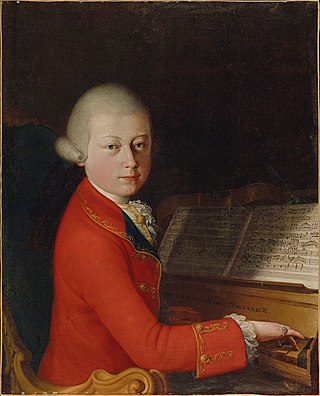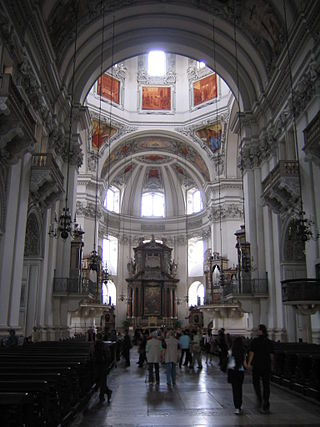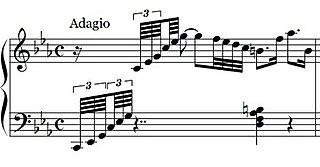The Piano Sonata No. 16 in C major, K. 545, by Wolfgang Amadeus Mozart was described by Mozart in his own thematic catalogue as "for beginners", and it is sometimes known by the nickname Sonata facile or Sonata semplice. Despite this, the sonata is actually not an easy work to perform and can hardly be described as "for beginners."

Ludwig van Beethoven's Piano Sonata No. 8 in C minor, Op. 13, commonly known as Sonata Pathétique, was written in 1798 when the composer was 27 years old, and was published in 1799. It has remained one of his most celebrated compositions. Beethoven dedicated the work to his friend Prince Karl von Lichnowsky. Although commonly thought to be one of the few works to be named by the composer himself, it was actually named Grande sonate pathétique by the publisher, who was impressed by the sonata's tragic sonorities.

The Piano Sonata No. 12 in F major, K. 332 (300k) by Wolfgang Amadeus Mozart was published in 1784 along with the Piano Sonata No. 10 in C major, K. 330, and Piano Sonata No. 11, K. 331. Mozart wrote these sonatas either while visiting Munich in 1781, or during his first two years in Vienna. Some believe, however that Mozart wrote this and the other sonatas during a summer 1783 visit to Salzburg made for the purpose of introducing his wife, Constanze to his father, Leopold. All three sonatas were published in Vienna in 1784 as Mozart's Op. 6.

The Symphony No. 1 in E♭ major, K. 16, is a symphony written in 1764 by Wolfgang Amadeus Mozart at the age of eight years. By this time, he was already notable in Europe as a wunderkind performer but had composed little music.

The Piano Concerto No. 20 in D minor, K. 466, was composed by Wolfgang Amadeus Mozart in 1785. The first performance took place at the Mehlgrube Casino in Vienna on 11 February 1785, with the composer as the soloist.
C minor is a minor scale based on C, consisting of the pitches C, D, E♭, F, G, A♭, and B♭. Its key signature consists of three flats. Its relative major is E♭ major and its parallel major is C major.

The Piano Sonata No. 13 in B-flat major, K. 333 (315c), also known as the "Linz Sonata", was composed by Wolfgang Amadeus Mozart in Linz at the end of 1783.

The Kegelstatt Trio, K. 498, is a piano trio for clarinet, viola and piano in E-flat major by Wolfgang Amadeus Mozart.

The Piano Sonata No. 14 in C minor, K. 457, by Wolfgang Amadeus Mozart was composed and completed in 1784, with the official date of completion recorded as 14 October 1784 in Mozart's own catalogue of works. It was published in December 1785 together with the Fantasy in C minor, K. 475, as Opus 11 by the publishing firm Artaria, Mozart's main Viennese publisher.

Wolfgang Amadeus Mozart's Piano Sonata No. 8 in A minor, K. 310 / 300d, was written in 1778. The sonata is the first of only two Mozart piano sonatas in a minor key. It was composed in the summer of 1778 around the time of his mother's death, one of the most tragic times of his life.

The String Quartet No. 19 in C Major, K. 465 by Wolfgang Amadeus Mozart, nicknamed "Dissonance" on account of its unusual slow introduction, is perhaps the most famous of his quartets.

Wolfgang Amadeus Mozart began his series of preserved piano concertos with four that he wrote at the age of 11, in Salzburg: K. 37 and 39–41. The autographs, all held by the Jagiellonian Library, Kraków, are dated by his father as having been completed in April and July of 1767. Although these works were long considered to be original, they are now known to be orchestrations of sonatas by various German virtuosi. The works on which the concertos are based were largely published in Paris, and presumably Mozart and his family became acquainted with them or their composers during their visit to Paris in 1763–64.
The Quintet in E♭ major for Piano and Winds, K. 452, was composed by Wolfgang Amadeus Mozart on March 30, 1784 and premiered two days later at the Imperial and Royal National Court Theater in Vienna. Shortly after the premiere, Mozart wrote to his father that "I myself consider it to be the best thing I have written in my life." It is scored for piano, oboe, clarinet, horn and bassoon.

Wolfgang Amadeus Mozart's Piano Sonata No. 9 in D major, K. 311 / 284c, was written on the composer's stay in Augsburg and Mannheim in November-December 1777, and is contemporaneous with his Sonata No. 7 in C Major K. 309. The three sonatas K. 309–311 were published as a set 'Opus IV' in about 1782, by Franz Joseph Heina in Paris.

Wolfgang Amadeus Mozart's Piano Sonata No. 1 in C major, K. 279 / 189d (1774), is a piano sonata in three movements. It was written down, except for the first part of the opening movement, during the visit Mozart paid to Munich for the production of La finta giardiniera from late 1774 to the beginning of the following March. It is the first of his 18 piano sonatas. A typical performance of the sonata takes about 14 minutes.
Wolfgang Amadeus Mozart composed six sonatas for keyboard with accompaniment of violin and cello, K. 10–15, in late 1764 in London during the Mozart family's grand tour of Europe. Queen Charlotte commissioned them on 25 October, and the works were dedicated to her on 18 January 1765. They were published as Mozart's "Opus III" by his father Leopold at 20 Frith Street, Soho, London, where the Mozarts lived from September 1764 until after May 1765.

The Missa brevis No. 9 in B-flat major by Wolfgang Amadeus Mozart, K. 275/272b, was probably written before September 1777 for Salzburg. The mass is scored for SATB soloists, SATB choir, violin I, violin II, 3 trombones, string bass, and organ.

Fantasia No. 2 in C minor, K. 396/385f is a fragment of a violin sonata composed by Wolfgang Amadeus Mozart in Vienna in August or September 1782.













